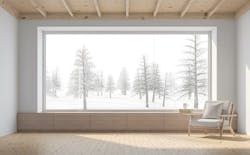Using Conventional Materials to Reduce Embodied Carbon Footprint
Builders for Climate Action have found that embodied carbon accounted for an outsized portion of greenhouse gas emissions for new low-rise construction. A new white paper from the group says that the carbon footprint can be significantly reduced by using conventional materials. The highest embodied carbon came from a building with high-Portland-cement concrete, and extruded polystyrene and spray-foam insulation. A typical model included concrete with some supplemental cementitious materials (SCMs), along with mineral wool insulation.
A lower-carbon alternative, called a “drawdown building” incorporated high-SCM concrete, and cellulose and wood fiber insulation. The carbon-storing model included:
- Insulated concrete forms with high-SCM concrete
- Expanded glass sub-grade insulation
- Straw and wood fiberboard insulation
- Wood cladding
- Compressed straw panel interior walls
- ReWall interior finishes
- Wood windows
- Linoleum and Forest Stewardship Council-certified softwood flooring
- Cedar shake roofing
An energy-efficient drawdown building located in Toronto and using renewable grid electricity would avoid 614 metric tons of carbon emissions over 30 years, according to the report. One caveat: Drawdown buildings rely heavily on wood products, and there are emerging questions about whether wood is universally a carbon-storing material.
